How To Make Your Own SVOD (Mini-Netflix!)
Chances are, you’ve heard of the Yoga With Adriene YouTube channel. But another one of our big projects has been kind of flying under the radar — even though I would consider it a huge success.
I’m talking about our SVOD service: Find What Feels Good.
While the revenue from YouTube is nice, this membership site has become a critical part of our business.
What does SVOD stand for?
SVOD is an acronym for Streaming Video On Demand. It’s a membership site where the majority of the content is video. Internet entrepreneurs (and porn sites) have been creating these from the moment video streaming was possible, back when it barely worked. Once bandwidth increased and video got easier, the entertainment industry got involved. The “suits” needed a new term that would look tidier on an Excel spreadsheet; thus SVOD was born.
In conjunction with SVOD, you’ll frequently hear the term OTT which stands for Over The Top. That means there is an app that makes SVOD accessible through TVs.
FWFG features the entire YWA library (ad-free) + all our standalone courses. We’re also adding exclusive content all the time. Currently, we have over 50,000 members and it continues to grow.
We run the entire thing through a platform called Uscreen. It’s an all-in-one platform for the website, mobile and TV apps. It’s a video-centric CMS that makes it easy to organize and publish content.
We upload a video, add thumbnail + metadata, and click publish. BOOM. It’s immediately available everywhere.
But it wasn’t always so easy.
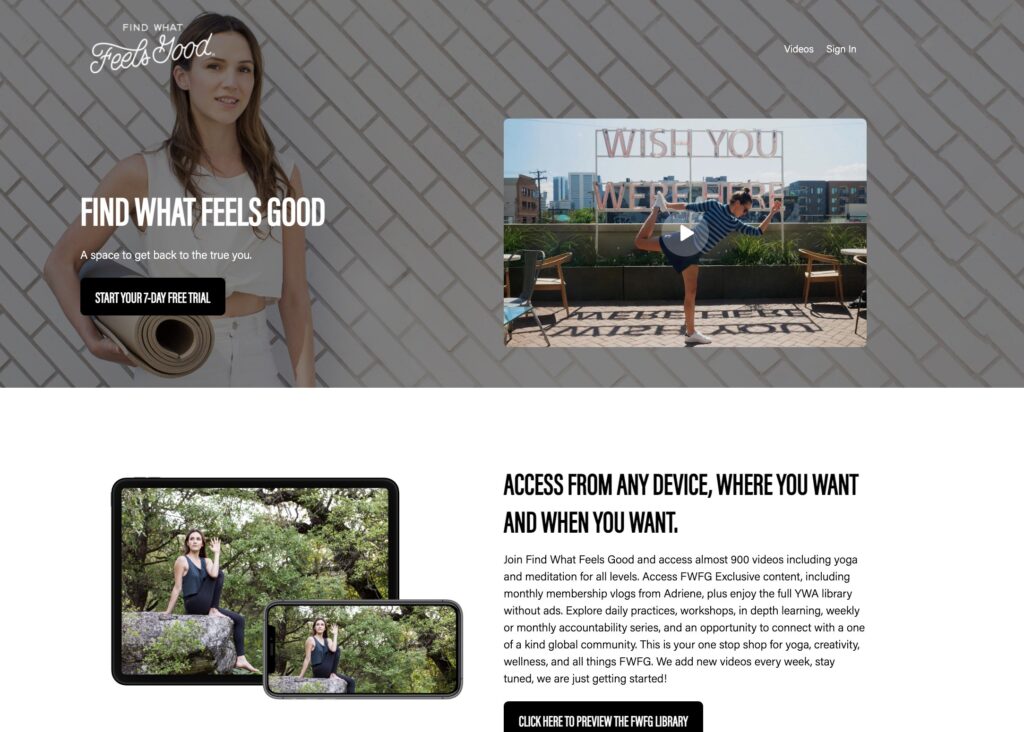
2015. An accidental SVOD.
In 2015, the Yoga With Adriene YouTube channel was a little over three years old. YouTube was finally bringing in a little revenue, but it wasn’t consistent, and we didn’t feel like we could depend on it. The AdSense revenue was nothing compared to the exclusive courses we had been launching. At that point, we had Reboot, Prenatal Yoga, and Empower available. We were gearing up to launch Rise: Morning Yoga.
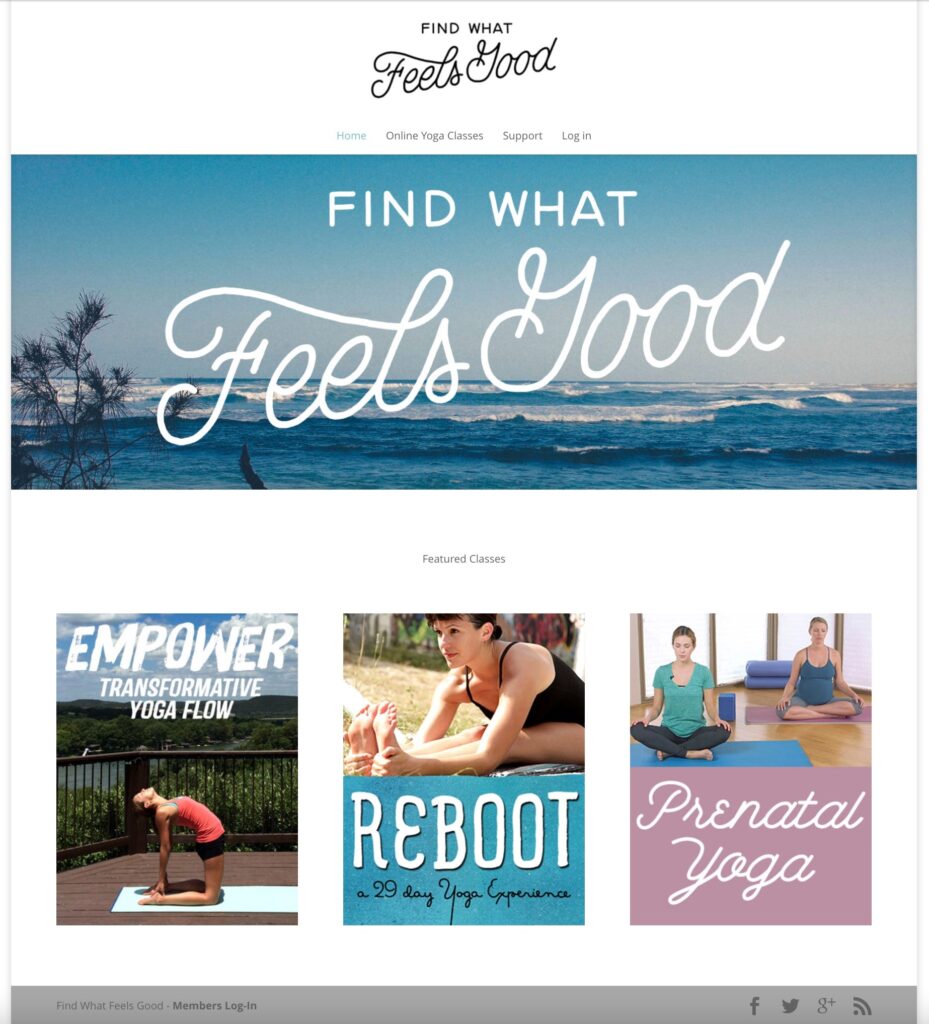
To sell these courses, we had spent a few years muddling our way through various systems that we had cobbled together with WordPress and various membership plugins. It was a customer support nightmare.
Then we heard about a new company called VHX.

VHX was an all-in-one system for selling video content that was years ahead of its time. It was created by a group of independent filmmakers who built it in order to sell their movies. Once we discovered it and talked to them, we moved everything over. We loved the team, and we loved the platform.
As soon as we moved to the new platform, our revenue immediately increased, and our customer support issues dropped to almost zero. It was also so well-designed that it was a delight to use.
After we had been selling standalone courses for a few months, the team at VHX reached out to let us know that they were about to release a new subscription feature (SVOD). They had a great plan for a complete system – not just the website but a full suite of custom apps for iOS, Android, Roku, etc.
Since we were already one of their biggest customers, they asked if we’d consider being one of their first two beta clients for the subscription service.
And they offered to set all of it up for free.
We weren’t ready. Or were we?
We didn’t think we had enough content for a viable subscription service at the time, but it was exciting to think about.
In fact, it was so exciting that I couldn’t stop thinking about it.
I was confident that this was the direction things were going, and I didn’t want to miss out on this opportunity.
So we came up with a plan. We decided to offer our three existing courses, plus the upcoming course that people were already excited about, along with the entire Yoga With Adriene content library ad-free. We even had a handful of videos that had received weird copyright strikes on YouTube that we had taken down. We decided to add those as well. And to round it out, Adriene was going to create monthly vlogs.
We decided to launch with that, and if everything went well, we’d come up with a plan to create more exclusive members-only content. We would sell it for $10/month.
So we got to work uploading and organizing videos on VHX. We worked with the team to create the apps. Slowly but surely, it was coming together, and it was very cool.
We just weren’t sure how our community would respond. If you have spent much time in the YouTube ecosystem, you’ll know that putting a price tag on anything can be tricky. It’s not as bad now, but in 2015 you couldn’t sell much without being called a sell-out.
Luckily we had an email newsletter and a blog.
The Launch
In November 2015, we wrote about the new direction and opened the doors as a soft launch.
There were a few unhappy people, and they made sure to let us know about it in the comments. Those are always a little hard to take since we had worked so hard on it and really felt like our hearts were in the right place. The negativity caused us to second guess ourselves and made us wonder if we had made the right decision.
In fact, if we had only been paying attention to the comments, we might have shut the whole thing down and gone back to standalone courses.
But sales were coming in. And the new people who were joining seemed overjoyed about it.
By the end of the first 24 hours, we had over 500 members.
And people were continuing to sign up.
At a price point of $10/month, we were making an additional $5,000 in monthly recurring revenue.
This was revenue that didn’t depend on the whims of the YouTube algorithm or how well we executed a course launch. These founding members had expressed a vote of confidence in what we were doing.
It re-energized us.
Then it was up to us to keep these people happy, engaged, and benefitting from the videos.
This was a whole new world, and as usual, we had no idea what we were doing.
How much new content did we need to publish? What the heck is a churn rate? How do we organize everything so that it’s not overwhelming? How do we balance this and the YouTube channel? How do we promote it without annoying people?
From 500 to 27,000 members
The obvious plan would be to start creating new membership videos every week. But we definitely didn’t have the bandwidth for that at the time.
Instead, we decided to go for quality over quantity and also to focus on the community experience.
I hoped this would also help us avoid the issue of content overwhelm. Content Overwhelm is one of the leading reasons members cancel a subscription service. They log on and see a lot of videos, get overwhelmed by the options, and are unsure of what action to take. Many of them give up, close the windows, and are then more likely to cancel. They’re not getting the experience they hoped for when they joined.
More content isn’t always the answer.
Our strategy: We would continue to do what we had already been doing. We would create several high-quality standalone courses per year. And we would work to create a sense of community around them.
Each course would get a proper promotional launch. We would make some of them available for standalone purchases as we had in the past. You could buy the course for $49, or you could get it as part of a $10/month membership along with a bunch of other cool courses. Plus, there was a free 7-Day trial, so you could try the whole thing out for free.
Luckily, we had a great new course that was almost ready to launch. We also had a 3-video series we had recorded at a retreat in Nicaragua. Adriene’s monthly vlogs would supplement these and put everything in context. This was all on top of the complete YWA library (ad-free) and the previous premium courses.
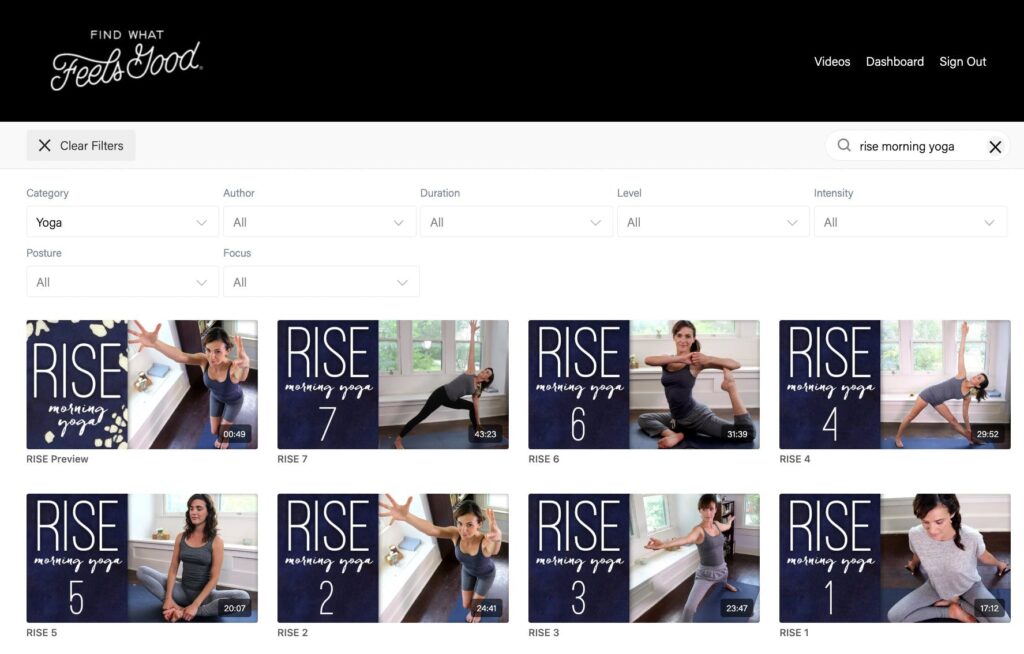
We had one other ace up our sleeve.
A few months earlier, a member of our community had started creating yoga calendars. Our previous courses had all had a calendar, but we’d never done anything for our regular videos.
In January, we reached out and offered to pay her to keep creating these calendars. We soon went on to hire her as our Community Manager.
Sarah created a theme for each month and suggested a daily yoga practice. The calendars were downloadable PDFS with clickable links for each day. Sarah shared them with the community every month – for free. People loved them!
In the beginning, the calendars only linked to free YouTube videos. As an experiment, we also started to highlight some of the membership content. People started to click through and check out what we were doing on the membership.
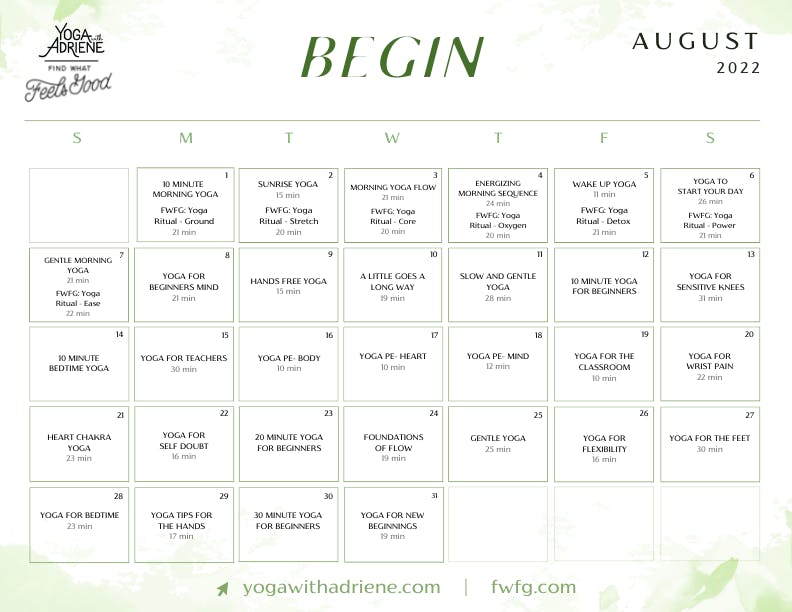
We weren’t selling; we were providing valuable content. And it worked. With zero advertising, the membership started to grow.
This free PDF calendar now gets millions of downloads per month.
It’s also responsible for driving traffic to the membership every day. If a video is on the calendar, it immediately gets thousands of views – even if it’s available on YouTube for free.
In its first four years, the membership grew from 500 members to 27,000 members. This was with zero paid advertising. We only used the calendar, a weekly email, and links in the YouTube description.
Launching any sort of membership can be daunting. We didn’t think we were ready. We didn’t think we had enough content. We didn’t think we had a big enough audience.
But it worked.
From 27K to 60K Members
That brings us to 2019.
Our focus was still on the YouTube channel. But in the background, FWFG continued to plug along. It wasn’t thriving, but it wasn’t declining.
Aside from the PDF calendar and links in the YouTube videos, we still weren’t actively promoting it. But it continued to hang in there. It was now more profitable than the YouTube channel, but it was a little neglected.
We continued to create new content and even started to introduce new instructors. So far, the response had been positive.
I was still focused on the content and continuing to improve the experience in both the apps and the browser version. I’ve mentioned it before in this newsletter, but I can get lost. I tend to chase after things far beyond the point where they are profitable. I couldn’t get excited about promoting FWFG because I didn’t think it was good enough yet.
In reality, it was already great. I knew people loved it. They told us every day.
But, I knew it could be even better. I thought about it constantly – trying to figure out how to take it to the next level…
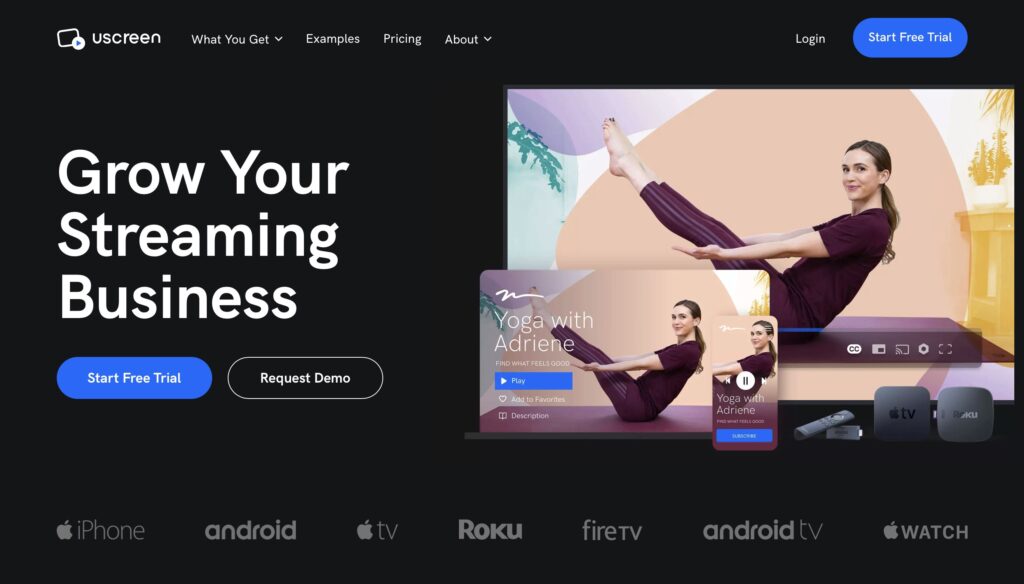
Obsession
This obsession led us into one of the most traumatic and stressful times our business has ever gone through.
I became convinced that the company we were using for our SVOD platform was trying to rip us off. Some weird things had happened behind the scenes. This made me believe their sales team for this was using FWFG in sales presentations without our knowledge. They may have even been revealing sensitive information about us to sign up new clients.
This all happened as I was growing frustrated with our inability to add new features to and expand our apps. I had a list of things I wanted to do:
- Integrate the calendar feature into the app
- Completely redesign the apps to be on-brand
- Offer customizable playlists and search filters
None of these things were possible with our current solution.
In my quest to find a way to create these features, I found a company called VidApp. VidApp creates apps that integrated with platforms like Uscreen, WordPress, Kajabi, etc.
I had built a relationship with the team at VidApp when I was part of the Commune start-up. I liked working with them and loved their product. But VidApp was running into issues working with our SVOD vendor. I felt like they were being treated unfairly as well.
I had also been intrigued by Uscreen for awhile and had already had a few conversations with PJ, their CEO. The platform looked great, but at the time was a little limited when it came to apps. But the combination of Uscreen and VidApp was very compelling.
Over a few meetings at VidSummit 2019, we hatched a plan. We would ditch our current solution and move the entire thing to Uscreen (browser) and VidApp (apps). This wouldn’t be an easy task. In fact, it was going to be a huge pain in the ass.
Most software platforms count on locking you in. Some of them don’t even let you use your own Stripe or merchant account for payment processing. We were not only going to have to move all of our video content. We also needed to migrate all of our members and untangle the payments to somehow transfer all that as well. We’d have to do everything without interrupting the experience for our members. Fortunately, we had a great team in place and a data genius ready to do most of the heavy lifting. (Shoutout to Kade!).
It would all be worth it if we could achieve our goal: a re-designed and vastly improved suite of apps. New features would enable members to access the monthly calendars from within the app, and even schedule their own.
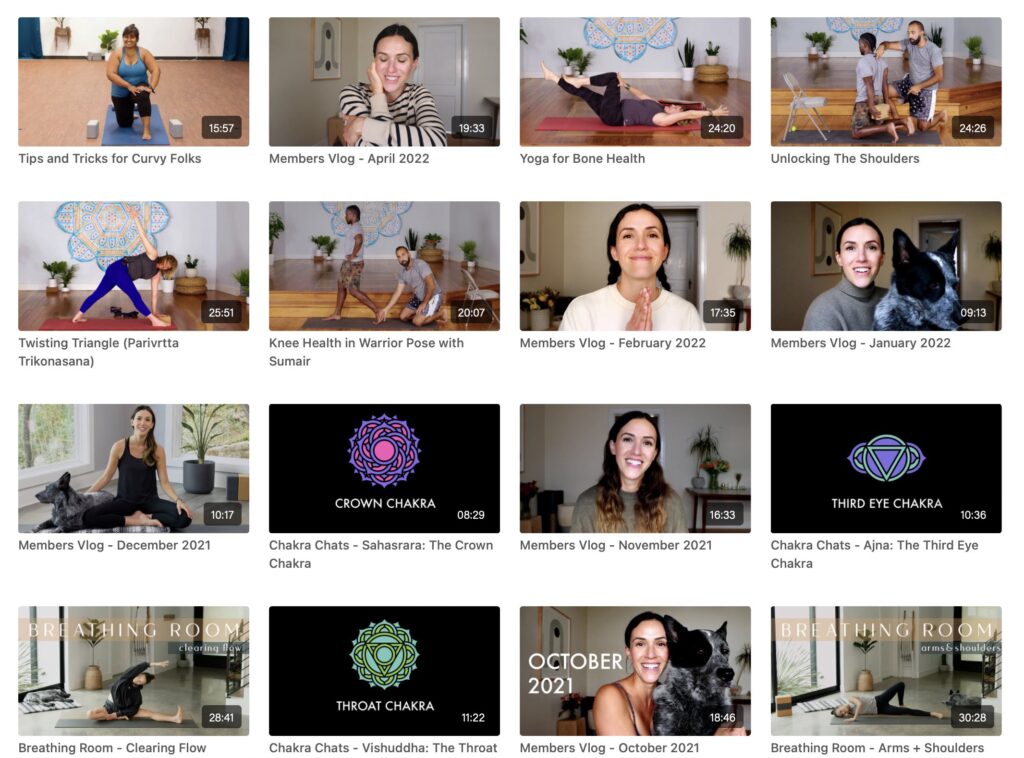
Relaunch
The team at Uscreen fired up a new account. Sarah got to work moving the video. Kade began working his data wizardry. I found myself on non-stop phone calls and video meetings. There was some subterfuge involved because we felt trapped. We had lost trust in our software vendor and wanted to escape.
Somehow we pulled it off. We moved everybody over. We redesigned the apps. We messaged all our members to keep them in the loop.
It wasn’t perfect. There were definitely some speed bumps – especially with the Android apps. Our customer support worked overtime to make sure our members felt happy and taken care of.
Once the dust had settled, we had an entirely redesigned platform with all the features we wanted. The member experience was vastly improved, and just as importantly – we were proud of it. After that, the promotion came naturally. We wanted to talk about it. Our membership numbers began ticking up again.
Some of the most effective promotion came from our members telling their friends. They were organically spreading the word. Our reviews in the App Stores started to improve – soon getting up thousands of reviews with 5 star rankings. This increased our position in the App Store search results which also increased our sign-ups through those platforms.
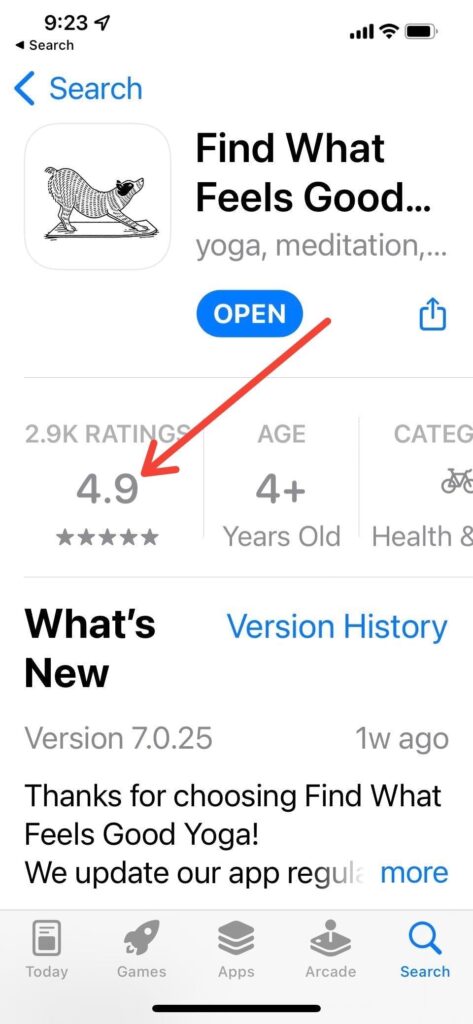
We soon passed the 30,000 members milestone. Months later, we passed 35,000. We were all feeling re-energized and in a good groove. We started releasing new content on a regular basis. We promoted FWFG in both the weekly email and across social media.
It felt like we were on the right track, and everything was finally working.
Then we rolled into March 2020. Covid hit, and society shut down.
Shutdown
We had no idea what was going to happen or how this would impact our business. We were unsure of when we would be able to get together to create new content. We were all freaked out and distracted. At that point, we had no idea how long any of this was going to last. It felt impossible to focus on work when everything had suddenly destabilized.
We took our foot off the gas. We kept the calendars and emails going and did whatever we could from the isolation of our own homes. I prepared myself for at least a year of whatever was happening. We had resources on hand, and I knew we could make it a year even if everything dropped to zero.
But the numbers didn’t drop.
Gyms were now closed, and people were turning to the internet and for alternatives they could use at home. Thanks to the YouTube channel and the new apps, people were finding US. Our membership numbers skyrocketed and more than doubled over the next 60 days.
By now, we had a large library of content, most of which was totally new to our YouTube audience. Despite one surge of activity that temporarily knocked our site off-line, everything was now working great. All the hard work and stress we had poured into FWFG was paying off. And now we had the luxury of slowing down and riding out the storm.
Now, over two years later, things have more or less returned to normal. After the “covid-bump,” our numbers settled back down to around 50,000 monthly members. We are back to work, making new videos and promoting FWFG on a regular basis. Our monthly membership average has increased to a 60,000.
Our Tiny TV Station
Once we all finally realized that we were a content creation company — not a tech company — running our tiny SVOD service suddenly became a lot of fun.
It really is like being in charge of a mini-Netflix or a tiny TV station.
We come up with ideas we’re interested in and green light them ourselves. Like an animated series featuring Adriene’s dog and co-star Benji.

Since the subscriber base is smaller, we are able to really listen to our members and create videos THEY want to see. We DON’T have to worry about algorithms, watch time or optimizing our metadata, or hitting a weekly schedule.
We can do what we want — and see if it works.
Of equal importance: the recurring revenue has stabilized the business.
Our mission is to reach as many people as possible with FREE high-quality yoga videos. That’s what we do on the Yoga With Adriene channel — and it will always be free.
But these videos do cost money to make.
The income from FWFG is consistent. We can count on it and we use this to fund everything else that we do. We make more than we ever did with AdSense or brand sponsorships & we have a lot more control over it. I always feared AdSense could drop (or go away) overnight.
So if you’re a YouTuber or video Creator, I’d highly recommend looking into starting up your own SVOD.
It’s more work than a Patreon, but Uscreen makes it easy.
It could be a game-changer for your business, a new way to connect w your audience, and maybe even a lot of fun!
My final tip: Make sure that whatever SVOD platform you use allows you to fully access and export your customer information. It should also allow you to use your own payment platform. This will give you the flexibility you need in the future to grow once you know what is working. Avoid the lock-in. Don’t get trapped.
Uscreen is the platform I recommend to anyone with a video-centric business looking to build recurring revenue.
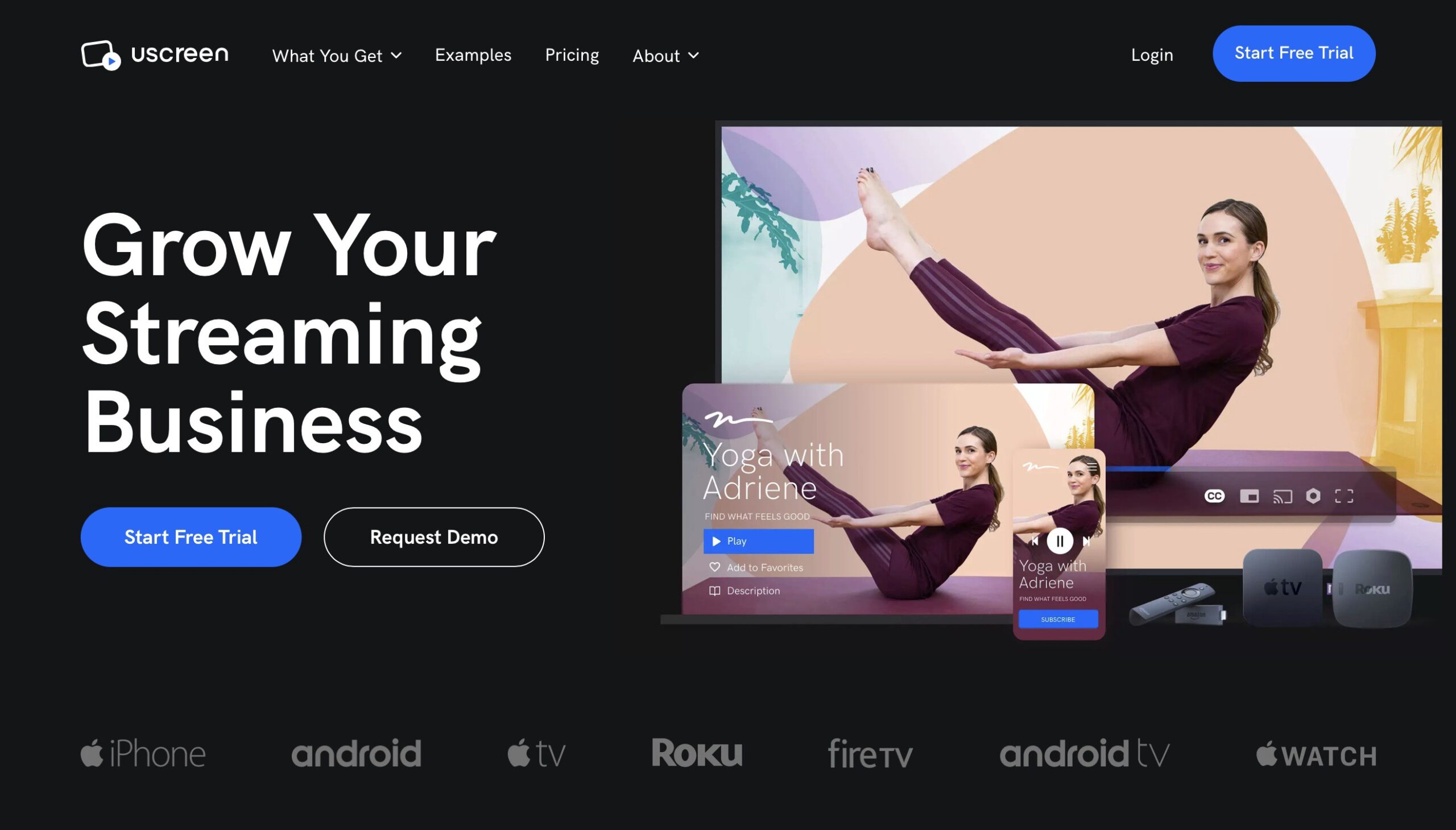
Always great information Chris! Looking for bonus points for the comments!!!
Bart, Founder of Most People Don’t
Hi Bart! First comment on the new site. Thank you!!!
Thanks for this Chris, super interesting and I actually had a call with Uscreen recently so they’ve been top of my list 🙂 I’ve used Teachable for my paid programs so far, but love the idea of a “Netflix-style” membership. Now just need to gear up for moving all my content and uploading YouTube videos, yikes! Look forward to the next email/blog.
Did you move your content? I’ve been using teachable and not a fan.
This is was super helpful, insightful and inspiring! Thank you for sharing your journey!
Thanks for sharing all this. It’s inspiring and so glad it all worked out. It’s very powerful and helpful content speaking personally!
THANK YOU for writing this!!! This was fascinating to read. I’ve been following YWA for a while, and now that I’m (re-)building my own community, which is currently hosted by Mighty Networks, I’m looking into a more video-centric platform.
Question for you: Knowing what you know now, if you were to start building everything YWA/FWFG today, would you still need VidApp? I’m not sure I understand it’s functionality/necessity from what I’ve seen with UScreen. Just curious.
Thanks again for taking the time to write this, seriously!!! This post is invaluable.
This was super helpful Chris, thank you for sharing your experience and insights. Congratulations to you and Adrienne on your massive success.
Kristina, Home RenoVision DIY
Thanks so much for such amazing content, exactly what I’ve been looking for.